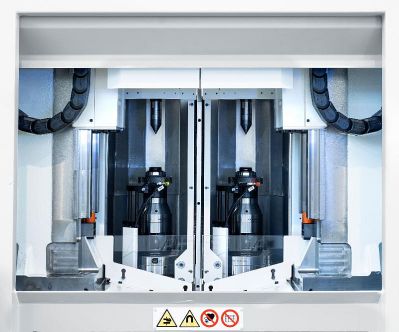"Tooth Flank" Grinding Machines Produce Near-Perfect Surfaces in Minimal Cycle Time
EMAG SU offers a large range of machine tools that cover the entire gear tooth cutting process. Tooth flank grinding, with the alternative cornerstone procedures of "generating grinding" and "profile grinding" is a key area of application.

The gear generating grinding machine G 160 is characterized by the unique machine structure. The simultaneous movement of all axes results in a chip-to-chip time of less than 2 seconds.
With "generating grinding," for example, the gear geometry is continuously "generated" by a combination of multi-axes, high performance machine motions and well-maintained grinding wheels.
EMAG SU's G 160 model is the fastest machine on the market for components up to module 3 with a maximum outside diameter of 160mm. The G 160 speed is made possible by an innovative slide axis concept with two parallel workpiece tables that take turns moving at high speed (with the help of durable, high performance linear motors) to the grinding wheel. During the time that one component is being machined, the loading robot inserts a blank into the other spindle, after first unloading the completed part, as needed.

Due to the axis concept of the G 160 from EMAG SU, the grinding head is very short, which has a favorable influence on reducing vibration behavior during grinding.
Self-centering alignment, or "meshing," of the grinding wheel to the rough-cut gear component takes place directly on the workpiece spindle, at load position, in parallel with the main machining operation. This results in a chip-to-chip time between the grinding processes of only 1.6 seconds (a very small value compared to grinding machines with turntables, where in some cases up to five seconds pass for the same process).
The actual grinding time needed for a typical component, such as a planetary gear wheel, is only about 10 seconds. The difference between the chip-to-chip times between grinding is therefore a real game changer. The floor-to-floor time is significantly reduced, by about 3 seconds (more than 20%), and the output quantity is massively increased. This is a decisive factor in the planning of high-volume manufacturing in the growing electromobility market.
Axis Concept Prevents "Ghost Frequencies" on the Surface
What also sets apart the technology of EMAG SU is the exceptional surface qualities that the innovative axis concept that the G 160 makes possible.

The G 160 has two parallel workpiece tables that move alternately at high speed to the grinding wheel. The integrated dressing unit provides additional process reliability.
Contrary to many other generating grinding machines, it has no tangential axis. Instead, the Y- and Z-axis "generate" a "virtual" tangential axis through a simultaneous movement. As a result, the point of contact between the grinding wheel and workpiece is around 100mm closer to the pivot point of the swiveling axis, which is beneficial for the swiveling behavior during the grinding process.
The wheel point of contact varies, thereby smoothing the gear form for better "mesh" and higher bearing ratios. The result is visible in the surface structure of the finished component, as the "ghost frequencies" in the micron range mentioned above vanish almost entirely.
Additionally, gear form Profile Deviation is very low, as measured by the FFA value (force-field approximation). The improved finish and form of the gears is due in no small part to the high rigidity of the G 160 and the innovative techniques of EMAG SU. Numerous shafts and gears wheels of the electric drive systems benefit from this quality.
G 250: Short Cycle Times and Maximum Flexibility
Another interesting machine concept can be found in the G 250 machine of EMAG SU, which is suitable for components up to module 7, with an outside diameter of 250mm.

The G 250 gear grinding machine from EMAG SU has been specially designed for short cycle times and premium quality and is used for mass production of gears with an O/D (Outer Diameter) of up to 250 mm and shafts with a length of up to 550 mm.
Axle drive gears, gear wheels or shafts with a maximum length of 550 mm can be produced with this solution, using generating grinding or profile grinding, with short cycle times. To this end, the machine is equipped with 2 table spindles to minimize idle time during the manufacturing process.
"Additionally, the flexibility of the machine was very important to us," explains Morhard. "For example, the G 250 can also be equipped with very small grinding wheels and worms." The G 250 HS variant also has a high-speed grinding head, which makes 20,000 rotations per minute possible, if a small grinding worm is used.
For large components in trucks or in general gear manufacturing, the cost-efficient G 400 rounds off the upper end of EMAG SU's product range for generating grinding. It is equipped with a tool table for components with a max. diameter of 400 mm and a shaft length of up to 750 mm. A feature that is important to many users: The machine can also be loaded from above, because the housing has an over-the-corner door.
Want more information? Click below.
Rate this article
View our terms of use and privacy policy ::m::